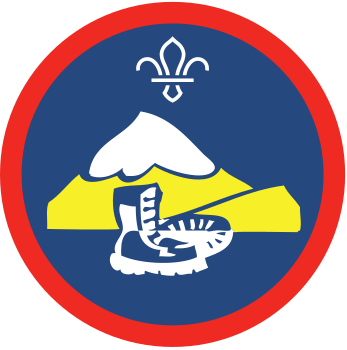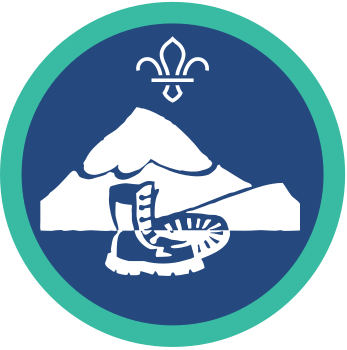Hill-seekers
You’ll need
- Clean items of recycling
- Access to a computer
- Camera or phone
- Camera extension equipment or supports, as needed
- Green tarpaulin
- Route-planning equipment
- Hill walking equipment
Before you begin
- Before planning a group hike, leaders and helpers should take a look at ‘Hillwalking’ on the Scouts A-Z for safety guidance and information on any permits they may need, and at the Hillwalking adventure listed under activities for what to expect and some handy hints.
- The steps below are best delivered across a series of sessions. ‘Route planning’ and ‘Set up some hilly scenes’ should be scheduled well in advance of the hillwalking adventure itself.
- Leaders should speak to everyone about equipment they’d like to take on their hillwalking adventure and showing how best to use them. Be sure to let everyone know what you have available at your meeting place already and what they’ll need to consider bringing themselves – this will be stuff they should bring to the meeting place for the ‘Set up some hilly scenes’ activity. For example their rucksack and hiking boots.
This doesn’t have to include any personal items that they would otherwise not share from their packs. Be sure to remind everyone that they may be bringing items that look similar to others in the group so labelling could be helpful.
- A leader or helper should familiarise themselves with the camera intended to be used for ‘Set up some hilly scenes’ so they can help those in the group who may need extra assistance.
Route planning
Run Mapping your adventure (walking adventure), or take a look at the activities linked to the Navigator Staged Activity Badge. These will provide you with detailed breakdowns of route planning with some useful onward linking to specific skills needed, it should help familiarise groups with their maps. This activity is estimated to take around 60 minutes, it is best to allow extra time to include thorough back up options in the route plans, for guidance on how to do this see Plan B prepared.
If the group is planning to use their expedition to contribute towards any challenge awards or other activity badges then be sure to check specific requirements here. There may be a particular terrain type, duration or length expected of the journey.
Set up some hilly scenes
- Altogether, clear the floor in or around your meeting place of obstacles so you have space for taking photos.
- Split into small groups.
Each person should have their own rucksack and equipment they’ve been asked to bring with them. If they are working towards their Scouts or Explorers Hill Walker Activity Badge then they must be sure to talk everyone through their hillwalking equipment with some detail.
- Take a look at the great photographs taken as part of What Scouts pack. These overhead shots show the young person lying down surrounded by the things they can’t be without when they’re spending nights away.
- Using these photos for inspiration, everyone should have a think about how each person in the group can take turns to recreate an overhead hilly shot. Each group can use tarpaulin, clean items of recycling and other items from around the meeting place to set their backdrop. Ideally, these shots should show them using some of the equipment they’ve brought with them. For example a picture might show a young person reading a map as they stride up a hill.
If everyone wanted to spend more time on this activity and get really creative they could use the Bedsheet backdrops activity to create something a bit more detailed.
- Take time as a group to get used to the camera and be sure to handle it with care. Decide whether you think any adjustments need to be made. It doesn’t matter if the camera doesn’t have lots of fancy features just as long as the lighting in the room is suitable to capture the shot.
- Figure out how you’re going to get that overhead shot. Each group should chat with an adult leader or helper about how best to safely achieve this. Think about how you can get the camera high enough, not necessarily the photographer, can you use a selfie-stick, tripod, stand on a stage or even a ladder. Whatever you use make sure that anyone going high is well supported and supervised by an adult.
- Switch around and ensure everyone that wants a go has had one. Groups should discuss equipment uses as they go and try to include as many hill-specific pieces of equipment or clothing as possible.
- When everyone has had a go, all backdrops should be tidied away and everyone’s personal belongings should be returned to them safely and stored securely.
- Everyone can use this time at the end to discuss whether they think they have everything they need for their upcoming adventure. Take time to share packing tips and chat about where to borrow or purchase items you don’t already have.
- If anyone needs to buy some new items for their hillwalking adventure there’s a Scout discount available at GO Outdoors.
Your hillwalking adventure
There are lots of different ways to have a hillwalking adventure. The Scouts A-Z is the best place to look for guidance.
Here are some suggestions as to how you could structure your days and things you could do along the way:
- Be inspired by the Swedes. Plogging is a combination of jogging and litter picking that started as an organised activity in Sweden in 2016. Rather than jogging with your packs, how about everyone designates a leg or two of their walk to litter picking as they hike – and if they really wanted to challenge themselves they could pick up the pace. The practicalities of this will have to be considered, a litter pick for instance, would require access to somewhere to wash your hands and responsibly dispose of waste.
- Geocaching. Sign up to Geocaching to join the world’s largest treasure hunt and search for caches near your route. There are a lot of different types of caches, but broadly speaking they are hidden containers dotted around the world for people to find using GPS co-ordinates. To learn more take a look at the website, and if this sounds like something you’d like to pursue further have a look at the activities linked to the Geocaching Activity Badge.
- Shinrin-yoku (Forest bathing). Any woodland along your route? Take some time to take a break and soak in the atmosphere. Use all of your senses to feel close to nature and recharge your batteries.
- Seek out a volunteering project. Keep your eyes open for potential conservation or maintenance projects that might need doing. Assess the conditions of the trails you’re passing and the wildlife habitats around you. Are there local authorities or land managers you could get in touch with to see how you could help? Take a look at Helping our hillsides for more information.
Reflection
Hillwalking presents an amazing opportunity for us to get outdoors, get up high and take in some of the best beautiful views out there. But it’s not always easy to reach these beauty spots. Have a chat as a group about what can help keep you motivated along the way. For instance, you could share a fitness goal you’ve been aiming for, or describe a rare species of wildflower that you’ll be looking for on the route. Share some morale-boosting tips with one another to help you persevere on your long journeys. When it’s all over, think back and reflect on how many of you listened to your own advice and what helped get you to that finishing line.
Safety
All activities must be safely managed. You must complete a thorough risk assessment and take appropriate steps to reduce risk. Use the safety checklist to help you plan and risk assess your activity. Always get approval for the activity, and have suitable supervision and an InTouch process.
- Hiking and walking
Follow the guidance for activities in Terrain Zero, or the guidance for each the adventurous activity.
- Phones and cameras
Make sure parents and carers are aware and have given consent for photography.
Depending on what skills you’re using on your hillwalking experience, how much practice you do in preparation will dictate how difficult the hike itself is for those taking part. Running activities from similar badges, perhaps with some adaptations to fit around your programme, unlocks a whole host of resources for helping everyone with skills like map-reading, packing their kit, navigation and emergency preparedness. If this isn’t for you, or you don’t have time, Scout Adventures have loads of useful documents to help leaders and helpers deliver this activity, from ‘Kit list’ to ‘Making sense of maps’. The helpful folks at GO Outdoors also give private demonstrations on the best kit to bring along, which could be very useful to attend.
- Check the route-planning guidance in Mapping your adventure for our statement on accessible routes.
- Anyone who doesn’t wish to be photographed should focus instead on setting up the backdrop and discussing the equipment with peers.
- Plan how you’ll reach the start point of your hillwalking experience, to check how accessible this location is for your group. Check for things like disabled parking and public transport links.
All Scout activities should be inclusive and accessible.
If everyone enjoyed hillwalking, think about some ways the group can get involved with action to protect hillside environments. You could tie this in with a volunteer project or make it the goal of your fundraising activities.
Everyone had the opportunity to steer this activity by choosing the nature of hillwalking experience to plan, discussing what to bring and helping one another prepare.

